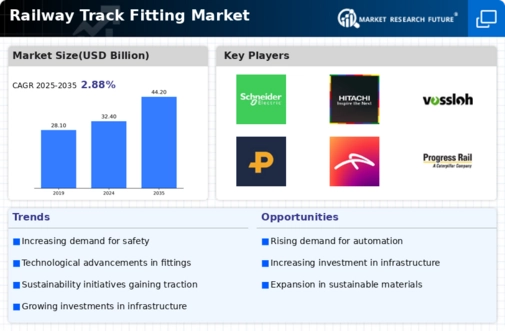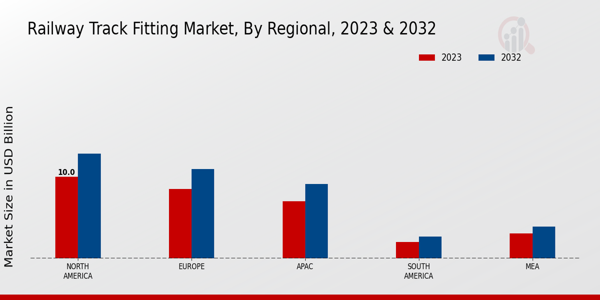Market Growth Projections
Urbanization and Population Growth
Urbanization and population growth are pivotal drivers of the Global Railway Track Fitting Market Industry. As cities expand, the demand for efficient public transportation systems increases, leading to the development of new railway lines and the upgrading of existing ones. For example, in rapidly urbanizing regions like Southeast Asia, governments are investing in rail infrastructure to accommodate growing populations. This trend is anticipated to boost the market, with forecasts suggesting a market value of 44.2 USD Billion by 2035. The need for reliable and efficient rail systems is likely to sustain demand for high-quality track fittings.
Increasing Infrastructure Investments
The Global Railway Track Fitting Market Industry is experiencing growth due to rising investments in railway infrastructure. Governments worldwide are prioritizing the enhancement of rail networks to improve transportation efficiency and reduce congestion. For instance, countries like India and China are investing heavily in high-speed rail projects, which necessitate advanced track fittings. This trend is expected to contribute to the market's expansion, with projections indicating a market value of 32.4 USD Billion in 2024. Such investments not only enhance connectivity but also stimulate economic growth, thereby driving demand for railway track fittings.
Global Trade and Freight Transportation
The Global Railway Track Fitting Market Industry is significantly impacted by the growth of global trade and freight transportation. As international trade expands, the demand for efficient rail networks to facilitate the movement of goods increases. Countries like the United States and Canada are enhancing their freight rail systems to improve logistics and reduce transportation costs. This trend is expected to drive the demand for railway track fittings, as robust rail infrastructure is essential for supporting increased freight volumes. The market's growth trajectory is closely linked to the dynamics of global trade, indicating a strong future outlook.
Technological Advancements in Track Fitting
Technological innovations are significantly influencing the Global Railway Track Fitting Market Industry. The introduction of smart track fittings equipped with sensors and monitoring systems enhances safety and maintenance efficiency. These advancements allow for real-time data collection, which can predict wear and tear, thus reducing downtime. Countries like Germany and Japan are at the forefront of implementing these technologies, which are likely to become standard in the industry. As the market evolves, the integration of such technologies is expected to drive growth, contributing to a projected CAGR of 2.88% from 2025 to 2035.
Sustainability and Environmental Regulations
The Global Railway Track Fitting Market Industry is increasingly influenced by sustainability initiatives and environmental regulations. Governments are mandating the use of eco-friendly materials and practices in railway construction and maintenance. This shift is evident in regions such as Europe, where stringent regulations are pushing manufacturers to innovate and adopt sustainable practices. The focus on reducing carbon footprints is likely to drive demand for railway track fittings that comply with these regulations. As a result, the market is expected to see a gradual transition towards more sustainable solutions, aligning with global environmental goals.



















